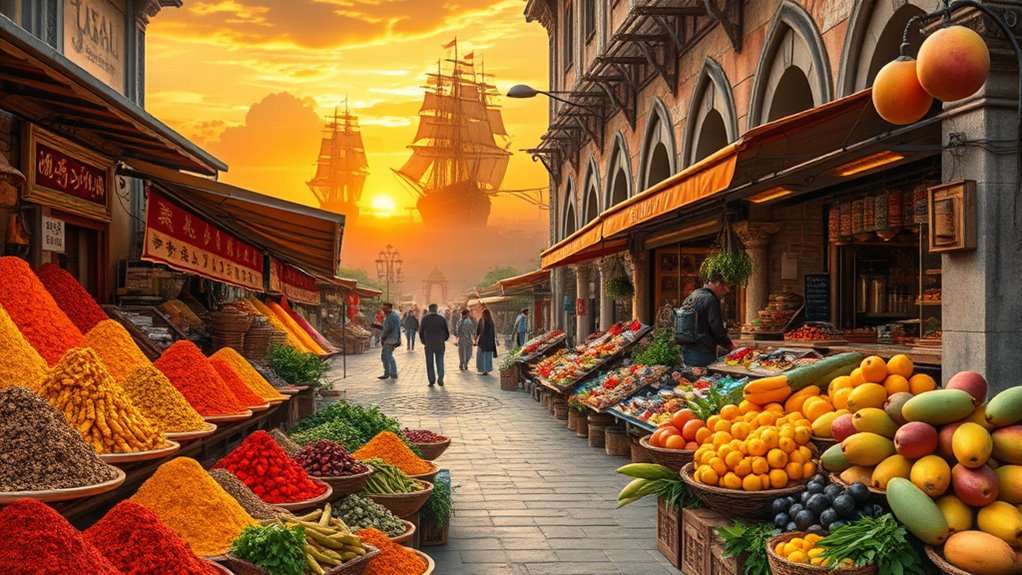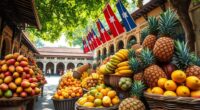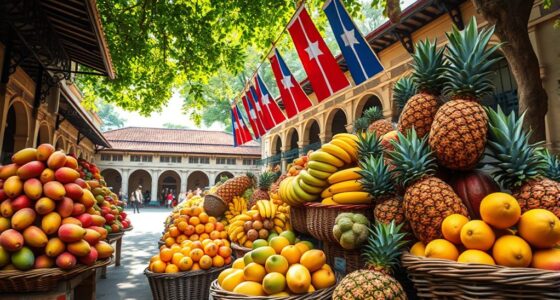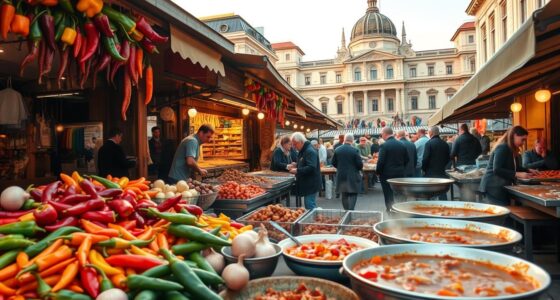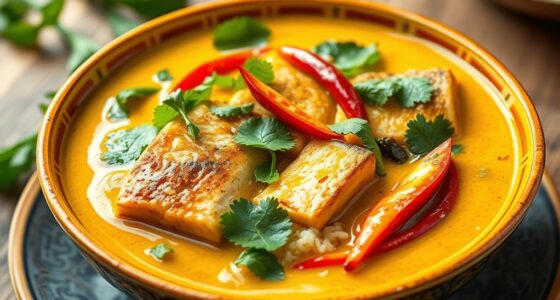Trade routes have profoundly shaped world cuisines by exchanging ingredients, spices, and cooking methods across continents. They introduced new flavors like tomatoes to Italy, chili peppers to India, and tea to many cultures. These routes also spread culinary techniques, cookware, and preservation methods, influencing local food traditions. As a result, global flavors are now interconnected, reflecting a rich history of cultural interactions. To discover how these exchanges continue to influence today’s dishes, keep exploring this fascinating culinary journey.
Key Takeaways
- Trade routes facilitated the exchange of ingredients, spices, and cooking techniques across continents, shaping diverse culinary traditions.
- The spread of signature ingredients like tomatoes, chili peppers, and spices led to new dishes and flavor profiles worldwide.
- Culinary techniques such as fermentation and cooking styles traveled along trade paths, influencing regional cuisines.
- Trade fostered cultural interactions that introduced new food preparation methods, ingredients, and dining customs.
- Modern globalization of cuisines stems from centuries of trade-driven culinary exchange and adaptation.
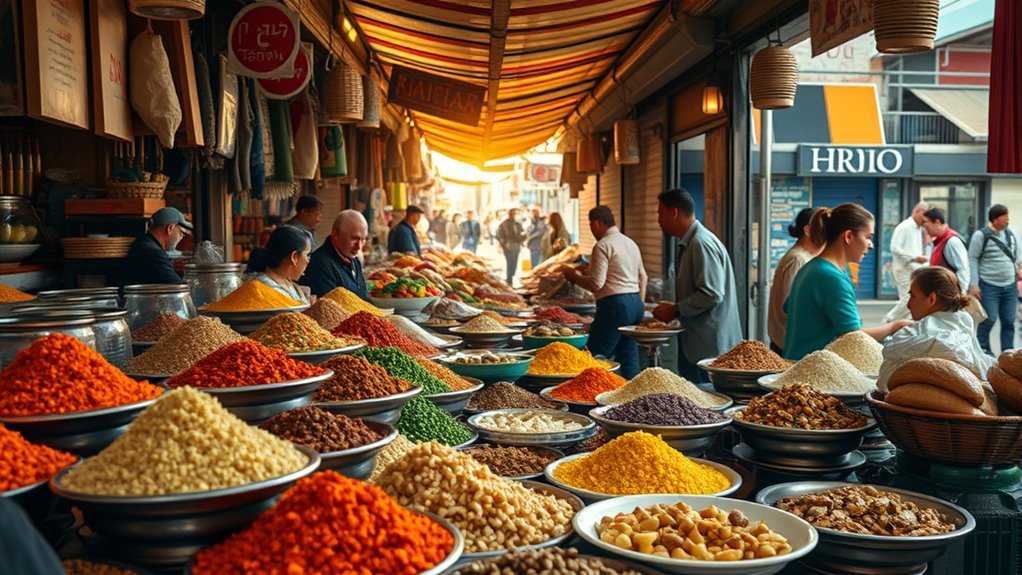
Trade routes have played a crucial role in shaping the diverse cuisines we enjoy today by facilitating the exchange of ingredients, spices, and cooking techniques across continents. When you think about your favorite dishes, it’s likely that their flavors, ingredients, or methods trace back to distant lands connected through these routes.
For example, the vibrant spices in Indian curries, the rich flavors of Mediterranean dishes, or the fiery kick in many Asian cuisines all owe part of their existence to centuries of trade. These routes didn’t just carry goods—they carried culinary traditions, inspiring cooks and communities to adopt, adapt, and innovate.
As you explore different cuisines, you’ll notice how certain ingredients are universally shared, yet uniquely prepared. The arrival of tomatoes from the Americas transformed Italian cuisine, giving birth to classic sauces and pizza toppings. Similarly, chili peppers, originating from Central America, became essential in Indian, Thai, and Mexican dishes, adding heat and depth.
Without trade routes like the Silk Road or the Spice Route, these ingredients might never have reached their current prominence in world kitchens. Instead, regional cuisines would be missing many of their signature flavors, and you’d experience a much more limited culinary landscape.
Trade routes also transmitted cooking techniques and ideas, shaping how dishes are prepared and presented. For instance, the method of fermenting foods, common in East Asia, spread along trading paths, influencing preservation and flavor profiles.
Likewise, the use of certain cookware, spices, or flavor combinations traveled across borders, enriching local cooking styles. When you try dishes from different parts of the world, you’re tasting a blend of cultural influences that have traveled through centuries of trade.
These exchanges enabled cooks to experiment, combining local ingredients with foreign ones to create new, exciting flavors.
Furthermore, trade routes fostered cultural interactions that went beyond food. They often led to the sharing of culinary philosophies and dining customs, which continue to influence how you enjoy meals today.
The spread of bread-making techniques from the Middle East, the adoption of rice cultivation in Southeast Asia, or the introduction of tea from China all demonstrate how interconnected our food traditions are.
You benefit from this rich history every time you savor a dish that combines ingredients or techniques from different parts of the world. Essentially, trade routes didn’t just move commodities—they moved ideas, transforming local cuisines into the global flavors you now enjoy.
A deeper understanding of these exchanges highlights how culinary globalization has shaped our modern palate, connecting us through shared food heritage.
Frequently Asked Questions
How Did Trade Routes Influence Regional Food Preservation Techniques?
Trade routes considerably shaped regional food preservation techniques by introducing new ingredients and preservation methods. You’d notice that as trade expanded, people adopted techniques like drying, fermenting, and salting to store surplus food and adapt to different climates.
These methods spread along trade paths, allowing regions to preserve foods longer, reduce waste, and ensure year-round food availability. So, trade routes didn’t just exchange goods—they transformed how communities preserved and enjoyed their foods.
What Role Did Trade Routes Play in the Spread of Culinary Spices?
You might think spices stayed local, but trade routes truly revolutionized their spread. As merchants traveled along silk roads and sea routes, they carried exotic spices like pepper, cinnamon, and cloves far beyond their origins.
This exchange made spices accessible across continents, transforming cuisines and culinary traditions worldwide. So, without trade routes, many of your favorite flavorful dishes wouldn’t have the diverse spice blends that define global cuisines today.
How Did Trade Routes Impact Traditional Cooking Utensils and Methods?
Trade routes transformed traditional cooking utensils and methods by introducing new tools and techniques across cultures. You might notice how the spread of metalworking allowed for sharper knives and specialized cookware, making cooking more efficient.
As you explore different cuisines, you’ll see how trade influenced the adoption of unique utensils like woks, tandoors, or mortar and pestle sets, reflecting the blending of culinary traditions shaped by historical trade connections.
Were There Any Cuisines That Remained Unaffected by Trade Routes?
Imagine a quiet island untouched by passing ships, where the local cuisine remains pure and unaltered. Similarly, some remote indigenous cuisines stayed unaffected by trade routes because they’re geographically isolated or haven’t interacted much with outsiders.
You see, these cuisines act as untouched islands in a vast ocean of culinary exchange, preserving ancient flavors and methods that haven’t been shaped by the ebb and flow of trade and cultural contact.
How Did Trade Routes Influence the Development of Fusion Cuisines?
Trade routes greatly shaped fusion cuisines by bringing diverse ingredients and cooking techniques together. You see, as traders traveled, they introduced new spices, fruits, and meats to different regions, inspiring chefs to mix flavors and styles.
This exchange created innovative dishes that blend culinary traditions. So, through trade, you get a rich, multicultural culinary landscape where flavors evolve and cuisines continually adapt, reflecting a history of interconnected cultures.
Conclusion
Imagine the world’s cuisines as a vast, colorful tapestry, each thread representing a trade route weaving flavors and traditions together. As you explore, you realize these routes are like rivers carrying spices, fruits, and secrets from distant lands, creating a vibrant mosaic. By understanding this, you see how trade routes shape every bite and aroma, turning your meal into a journey across continents. Embrace this interconnectedness, and savor the rich story behind every dish you enjoy.
